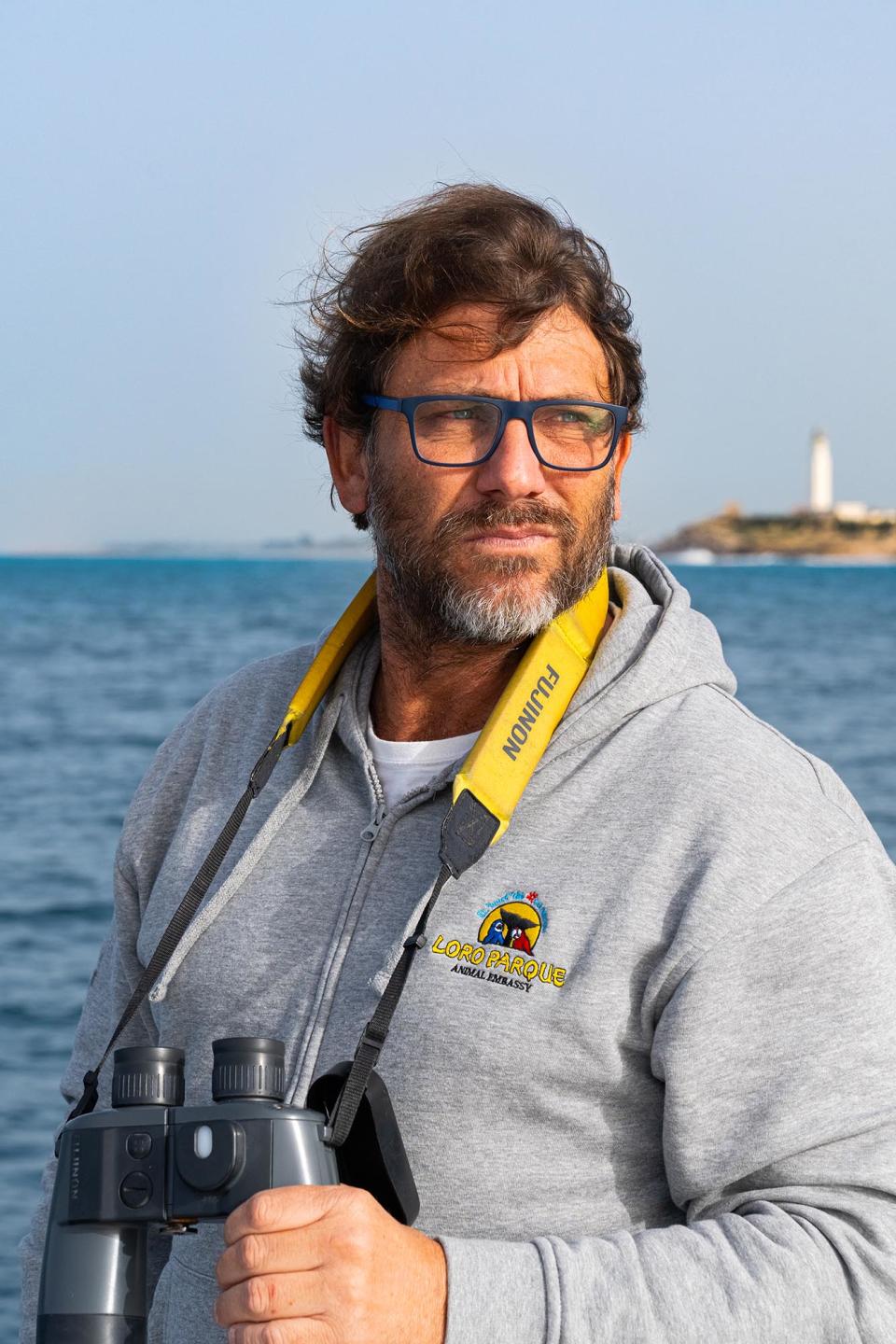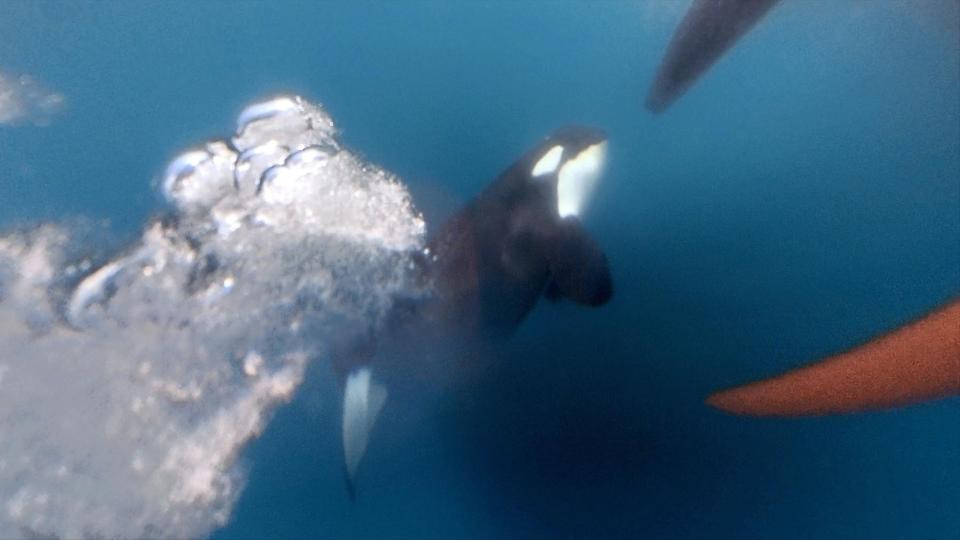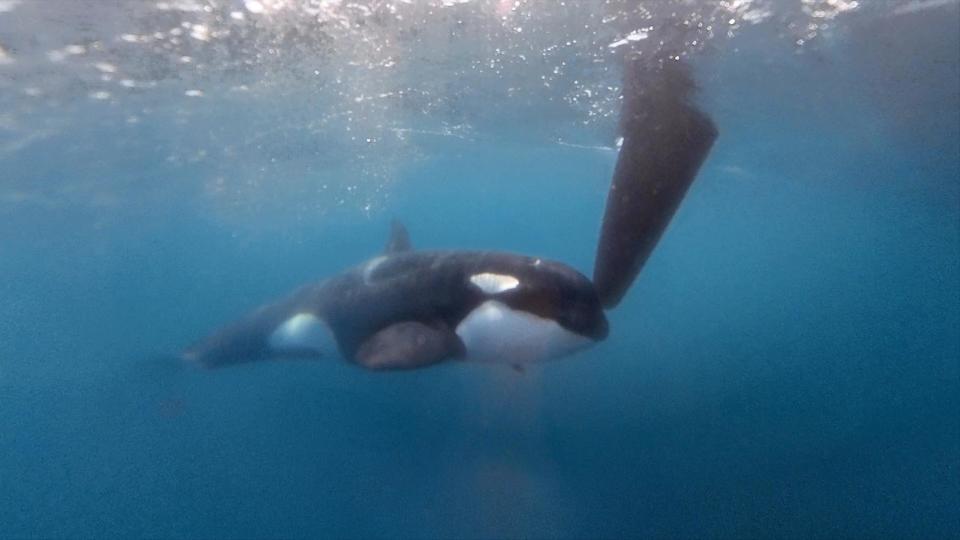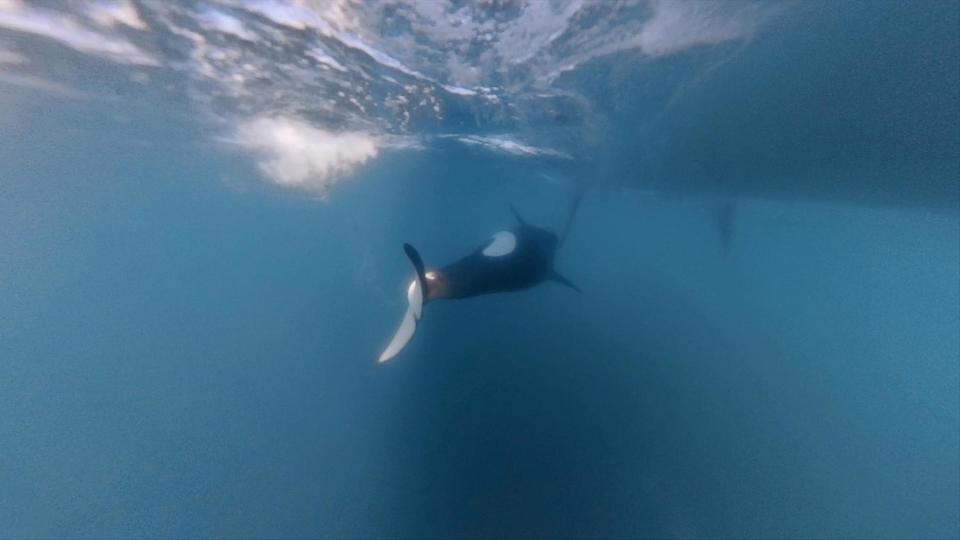The five animals took an hour to put the sailboat beneath the waves. At the end of October 2022, four men, each in his late twenties, set sail from western France toward Lisbon. Augustin Drion, an experienced sailor from Brittany, was one of them. He had come to lend a hand to a friend from engineering school, Elliot Boyard, who owned the 39-foot sailing vessel. From Portugal, they planned to cross the Atlantic to the Caribbean. They would cruise around the islands for a year. Then they would return home.
The crew had spent several days battling thunderstorms and high waves in the Bay of Biscay, the treacherous stretch of ocean to the west of France. They felt ragged. But on the morning after Halloween, the boat, called Smousse, crossed into the stiller waters off Portugal and the crew was able to relax. The sun was shining. The breeze was soft, and the boat was making seven knots. For the first time, conditions were calm enough to rely on the autopilot. Drion had just finished a watch shift and decided to join the others lounging on deck. He ducked inside the cabin to grab a book.
More from Rolling Stone
He heard a crash. The boat shook, and Drion lost his balance. “What happened?” he shouted up to the others. There was banging on the hull from the outside. The crew looked over the side and saw black fins breaking the glassy surface. Five killer whales, each more than half the length of the boat, their glossy skin shining in the sunlight, were taking turns swimming into the back of the sailboat, ramming the rudder with their heads. With each crash, the boat jolted into a new direction.
The crew shut down the electronics and hauled in the mainsail. Speeding off, they thought, could be an invitation to chase. The animals were faster. Better to stay put, quiet and still. They sat without talking for almost an hour, drifting in open ocean. The only sounds were the deep steady blows of orca breath, the clicks and whistles of killer whale language, the crunch of several tons of marine mammal — the boat weighed about the same as one adult male — against their rudder.
After a while, Drion began to worry about the boat’s structural integrity. He went down into the cockpit. This time, there was water on the floor. A steady stream flowed in from a crack in the stern. The boat was quickly flooding, and it was starting to sink. Boyard put out a mayday call. The nearest vessel was 60 minutes away, and the men inflated the lifeboat. They wanted to stay on the sinking boat for as long as possible, worried that the orcas might decide to sink their life raft, too — which would be catastrophic. But the water was rising quickly, and they all crowded into the blow-up dinghy. They looked around. The killer whales had gone. A Swedish yacht arrived to pick them up. The men watched the top of the sailboat’s mast disappear beneath the swells.
ORCAS VERY RARELY go for boats — that’s supposed to be the idea, but something new is happening off the Iberian coast. Since 2020, from the top of Portugal down to southern Spain, sailors have reported almost a thousand similar attacks. Almost every day, every spring and summer, yarns from anguished captains attaching photos of their beat-up rudders fill up a Facebook group called Orca Attack Reports, which has more than 60,000 members. The epicenter of the carnage is the Strait of Gibraltar. The slim stretch of sea between Spain and Morocco, the gateway to the Mediterranean, is one of the busiest shipping lanes in the world.
Many captains now carry illicit firecrackers on board to throw at the whales. Some blast death metal on Bluetooth speakers. Others bash steel sticks against their hulls when orcas approach. Orcas have sunk at least three boats and damaged hundreds more. Nobody has died. Wild orcas, as far as we know, have never killed a human being. But sailors worry it’s just a matter of time, while orca biologists are anxious about captains arming themselves and taking things into their own hands. “I wouldn’t be surprised if it’s not too long before we see someone attempting to shoot one of these animals,” says Luke Rendell, a marine-mammal expert at the University of St. Andrews.
The group of orcas that live around the Iberian Peninsula are the only killer whales that attack boats, and researchers know very little about them. There is only one scientific paper about their new hobby. The Portuguese government has advised sailors to stop moving if killer whales hit them, and wait for them to get bored — which is what Drion and Boyard did instinctively. The Spanish authorities, though, say keep going. In 2020, the Spanish government banned small sailing boats from a part of northwestern Spain. Meanwhile, the attacks are spreading. This community of orcas, documented in the Strait of Gibraltar since the Roman Empire, consists of nearly 90 animals. Some scientists believe that all of them now ram sailing boats. What triggered the behavior is unclear. One hypothesis, though, has taken off: The orcas are seeking revenge.

Orcas that have been documented attacking boats are called “Gladis” — from orca gladiator, one of the whale’s scientific names. Killer whales move around in matrilineal units, a mother with up to four generations of descendants. We don’t know which whale, or even which unit, was the first to start swimming into sailboats. Some believe it began in 2020 with Gladis Black — a male juvenile with a deep scar on his back from a wound, probably from a boat. Other researchers say it was Gladis White, an adult female from another unit. But whichever was the first, the others quickly began to copy them.
The notion of killer whales with vendettas against humans — whether for injuring them with boat propellers, or for picking their tuna hunting grounds clean, or for ruining the climate, or for capturing their brothers and sisters and imprisoning them in swimming pools — took the internet by storm last summer. You can buy stickers and mugs of the Gladis orcas. “Fuck them boats.” “Eat the Rich.” “Support for Comrade Gladis.”
But these aren’t superyachts. The orcas tend to leave fishing boats alone, too. The targets include humble craft, sailing boats of the kind you can buy for the cost of a cheap used car. For their owners and crew, many of whom are not, by sailing standards, especially wealthy, the attacks are terrifying. The most recent sinking was last October. There is no reliable way to deter them, and sailors are completely at their mercy.
Which is why, in January 2022, the Spanish government asked Renaud de Stephanis, a 48-year-old Spanish orca expert, to figure out a solution to the problem. De Stephanis, who has a grizzled beard, shaggy hair, and bronzed aging-surfer skin, has been studying this group of orcas since the 1990s. Last December, I flew to Gibraltar, crossed the border into Spain by foot, and drove west along the coast toward a ramshackle house perched upon a cliff above the strait to spend a week with him.


HIS HOUSE IS difficult to pinpoint in the hills above Tarifa, a hippie kite-surfing town at the southernmost tip of mainland Europe. I arrive at the door after getting lost, and a 27-year-old marine-biology intern named Maggie cracks it open. De Stephanis isn’t home right now, she says. He’s at sea. “Be careful,” de Stephanis had warned a few days earlier on Facebook: The orcas are now in the strait. Maggie isn’t sure how long he’ll be. But I can wait for him here.
A shed snakeskin of a sleeping bag lies on the threadbare couch. A cold wind whistles through a broken window, and cans of energy drinks dot the coffee table. “Here, we live like Peter Pan,” de Stephanis tells me a couple of days later — and in a bedroom on the first floor, which is stuffed with toys, including a couple of cuddly killer whales, Maggie points to my bunk. It’s de Stephanis’ daughter’s room. I’m to sleep there while the nine-year-old stays with her mother in Seville.
From the top of the house I can make out the cliffs of the Moroccan coast. A procession of freight ships chugs between the Pillars of Hercules, two promontories that frame the entrance to the Atlantic Ocean: one on the European side, the other in North Africa. For ancient mariners, the two pillars were a warning: Advance no farther. They marked out the edges of the known world and the start of nothingness. According to classical mythology, the Strait of Gibraltar was Hercules’ handiwork — eight miles across at its tightest point. Why would Hercules make it so narrow? To stop sea monsters from coming up into the Mediterranean, wrote Diodorus Siculus, an ancient-Greek historian. The protector of mankind had built a bottleneck for blocking civilization off from the wild.
There are three interns, and they tell me they hardly ever see de Stephanis, despite living in his little house for many months. “He has mad-scientist vibes,” one of them tells me over tapas. Some days, de Stephanis remains in his bedroom morning to night, announcing “Today doesn’t exist.” Or he waits out bad weather and rough swells in his sleeping bag in the living room with an old movie — Gladiator is his favorite. But as soon as conditions are right, he slips out onto the strait again, searching for Gladis.
Which is what he’s doing as I wait, passing the time trying to decipher a Spanish translation of Moby Dick I find on a shelf in his office, beside crossbow darts used for extracting whale biopsies. That evening, as de Stephanis steps through the door just in time for spaghetti and meatballs, I remember I’d read he was an ex-rugby player — his cetacean obsession had followed a short professional career, and he still has the physique of a feared enforcer. His wet blue eyes are a little bloodshot. They appear to intimidate the interns, who were chattering happily until the moment he walked in.
Nobody has died. But sailors worry it’s just a matter of time.
After dinner, de Stephanis kindles a log fire. He tells me about changing ancient seafaring routes, passages sailors had followed since before the ancient Romans. A few months earlier, he had announced that boats should avoid the deep waters in the middle of the strait where the orcas usually strike. Sailors obeyed, and today most vessels in the area hug the coast. Diverting boats seems to delight him. He stands up and starts pacing the living room. “Super fun,” he says. “I like it.”
Avoiding the hot spots is common sense. If de Stephanis gets such a kick out of rerouting the boats, though, I wonder as I watch him lope around, isn’t that something he shares with the killer whales, the creatures that are his life? Everybody seems to be having a great time redirecting sailboats. But are the orcas only having fun, or are the attacks vindictive?
THE MORNING OF Jan. 10, 2023, was cloudy and calm on the Strait of Gibraltar. De Stephanis and his team of five stepped into an inflatable Zodiac and sped out of Tarifa harbor in the direction of Morocco, past the statue of Christ at the port’s entrance. It was the first day of their government-funded project to understand how to deter the killer whales. First, though, the crew had to check if they were even around.
It was in these waters that once swam the first killer whales to ever be described in writing. “The killer whale, a creature that is the enemy of the other species and the appearance of which can be represented by no other description except that of an enormous mass of flesh with savage teeth,” wrote Pliny the Elder in A.D. 77, “charge[s] and pierce[s] other whales like warships ramming.” But in the winter, killer whales are less common in the Strait of Gibraltar. They often follow the bluefin tuna into the Atlantic, and de Stephanis didn’t expect to see them. Standing on the blow-up tube on the side of the boat, he scanned the horizon. He was not ready to begin any experiments. As far as he knew, the orcas never went for inflatable boats.
Once in the deep water, though, two killer whales started approaching them quickly from behind. Their black-and-white faces were rhythmically emerging from the water as they swam, their eyes fixed on the boat. The pair got closer and closer, until one lifted the Zodiac out of the water with a gentle tap of its nose. It happened again. Everybody on the boat was knocked toward the bow. De Stephanis’ heart was pounding. He worried the orcas would destroy the boat on their first day of work. “I wasn’t scared,” he tells me with a smirk. “OK, I was fucking scared.”
The killer whales played with the blow-up craft for about an hour. Sebastian Lang, a German photographer who lives in Tarifa, had come aboard for the ride. A few years earlier, Lang had been snorkeling at a nearby spot with pilot whales, long black cetaceans with bulbous foreheads that are the only animals Iberian orcas appear to fear. One of them took Lang’s arm in its mouth and swam down to the depths, delivering him back to the surface just before he passed out. As the orcas rammed the fragile inflatable, Lang zoned out again, but this time with a feeling of awe. “My brain shut off,” he tells me. “I wanted to look at them for hours and hours.”
De Stephanis powered back to shore at top speed. Over the next few months, he and the team ventured out as often as weather allowed. When a killer whale approached them, he stuck a GPS tracker onto its shiny back. This location data led to his recommendation that boats should avoid deep water. He experimented with keeping going versus stopping — and found that continuing led to fewer and less destructive attacks. A stationary boat, he found, makes for a better target.
He tried out a pinger that played a high-pitched sound, which some sailors say repels the whales, and found it seemed to attract them instead. He played recordings of pilot whale calls — but he worried they would drive the orcas out of the strait altogether, so he stopped. He dragged decoy rudders behind the boat to see which designs they preferred, and he deployed a prototype deterrent rudder covered with soft spikes. It appeared to be effective. What he failed to prove, though, was the reason for the behavior — although what conclusive evidence of that would look like is hard to imagine. Still, de Stephanis has a theory.
ON A BRIGHT and clear day a few months later, de Stephanis was approached by a group of orcas, including one with a deep wound gouged into his dorsal fin. It was Gladis Black. De Stephanis shows me underwater video he had taken with a GoPro attached to a stick. Beneath the boat, Gladis Black rotates into a vertical position, and presses and rubs the pointed black tip of his face against the rudder. His face and white chin are covered with scratches and scars.
Was he seeking revenge? This theory, it seemed, had originated with Alfredo López, an animal biologist at the University of Aveiro in Portugal. Lòpez believes that one of the orcas could have been harmed, perhaps by a fishing line, and that the behavior might be a response to injury. “Complete bullshit,” says de Stephanis, who has known Lòpez since 1999 through attending whale conferences, and has little respect for him. “I call him ‘the expert,’” he says with a mocking smile. “He’s no friend of mine.” He adds: “He knows I know that he has never seen an orca.”
When I reach out to Lòpez, he is too busy to speak with me. His team is inundated with whale carcasses that keep washing up on the coasts, his colleague, Mónica González, tells me over email. She adds that López had seen wild orcas “many times,” but that his personal history “matters little.”
It’s worth pointing out here that de Stephanis has attracted controversy, too. He has studied the orcas at Loro Parque, Spain’s version of SeaWorld, which still keeps four animals in captivity. The conservation foundation connected to the park has also given him grant money. De Stephanis says he opposes keeping orcas in captivity: We shouldn’t capture any more, he tells me — but as long as they are there, they can be useful to biologists.
Gonzàlez tells me she doesn’t care what de Stephanis thinks of Lòpez’s work. Still, team Lòpez and team de Stephanis battle it out in Facebook comments — and just as the attacks have become a craze among the orcas, Lòpez’s trauma-and-revenge hypothesis quickly became a meme among human onlookers. “Killer whales orchestrating revenge attacks on boats,” wrote the New York Post in 2020. “Revenge of the orcas?” asked the Washington Post in May 2023.
Every orca researcher I speak to agrees that Lòpez’s hypothesis is implausible. Even Drion, whose experience with the orcas felt like an attack, compares the whales to a powerful dog playing rough with a small child. It feels scary, and it’s certainly dangerous — but to the dog, it’s just a game.
If they wanted to sink the boat, they’d jump on it and the game is over.
“If they really wanted to sink the boat,” Drion tells me, “they would just jump on it and the game is over.”
But the attacks could still be a result of how humans have harmed killer whales, de Stephanis says. In 2010, overfishing decimated the bluefin tuna population. During that period, the orcas birthed fewer calves. With fewer siblings to play with, de Stephanis wonders, were boisterous juveniles choosing boats as their playmates instead? OK — but then why are the adults joining in? That’s not so surprising, he tells me. Humans aren’t so different. His daughter is trying to teach him TikTok dances.
Whether or not that story holds water, de Stephanis is convinced Lòpez’s trauma-and-revenge idea is wrong. The behavior is play through and through. But as de Stephanis fills the house with chaos, shouting and blasting Independence Day at 8 a.m., I can’t shake the idea that this interpretation, that it’s nothing but horseplay, overlaps almost too neatly with what he himself seems to share with the orcas.
His connection to killer whales has zero to do with what people sometimes talk about after swimming with dolphins. It has nothing mystical about it, nothing to do with wisdom, intuition, or serenity. What he shares with the animals is a rambunctious physicality, brute strength, friskiness, fluid rhythms of attention. He keeps reminding me of an unruly juvenile. Is there a chance he could be wrong? When pushed, he admits he can’t rule out the trauma-and-revenge theory completely. There is, he estimates, a five percent chance it is true. In any case, the probability is not zero. “Never,” he tells me. “I’m a scientist.”
STILL, DE STEPHANIS is probably right. If the orcas do intend to destroy boats and harm people on them, they could do that easily by smashing holes in the hull — but they never do. They are obsessed only with the rudder. And the idea that the behavior developed in reaction to an injury from a fishing line, or even because of overfishing, is dubious, because the orcas very rarely, to our knowledge, attack fishing boats — for unclear reasons. More than that, though, is the fact that every killer whale scientist I speak to repeats the same thing: These creatures just don’t carry vendettas.
Orcas have “one of the most elaborated brains on the planet,” says Lori Marino, a neuroscientist, expert in whale behavior, and founder and president of the Whale Sanctuary Project. An orca’s cerebral cortex is more convoluted, more intricately folded, than a human’s — which gives them an extraordinary ability to learn, remember, think, and feel. Killer whales lead a rich emotional life, and share some complex feelings with humans, Marino says. They experience empathy, they mourn their dead, and they are probably smart enough to understand why an individual might want to harm another in vengeance — to impart a lesson, for example, or to discourage future attacks. Which makes it even more remarkable that, in the wild, orcas never do.






In the 1960s and 1970s, when orcas in the northeastern Pacific were repeatedly terrorized by boats that kidnapped their relatives and put them into captivity, they never attacked vessels of any kind. Unlike highly intelligent terrestrial mammals, such as chimps, gorillas, or humans, there is very little evidence that wild killer whales have ever sought revenge. (Although orcas in captivity have killed trainers, those animals were probably psychologically disturbed by their environment, says Marino.) When a chimpanzee steals food, the victim often retaliates. An aggrieved macaque will settle scores, sometimes attacking a family member of the perpetrator. But orcas don’t do that. “They have adapted in a way that eliminates the need for aggression,” says Deborah Giles, a killer whale researcher at the University of Washington.
I wanted to speak with Hal Whitehead, the co-author of The Cultural Lives of Whales and Dolphins, a book that gripped me for days. Over Zoom, I ask Whitehead, who is a professor of biology at Dalhousie University in Nova Scotia, why orcas might have evolved to not hold grudges against other animals. He explains that while land mammals can be territorial, territory isn’t really a thing in the sea. With few fixed resources in the ocean, there’s less to go to war about. “It’s fluid. It’s flexible. Animals are moving around, here and there,” he says. And perhaps — now Whitehead is musing — we can learn something from that. “Some of us think that aggression and war are inevitable,” he tells me. But if sophisticated forms of ocean intelligence can teach complex land-bound brains a lesson, he says, it is that more-equal ways of dividing up resources across territories could make war and aggression less likely.
What looks like revenge against humans, Whitehead says, is a behavior that may be a kind of culture, a way this community of orcas now strengthens its group identity. Orca obsessions can quickly turn into collective fads. Take their eating habits. Most wild animals are not fussy gourmands. But the orcas that live in the seas around Antarctica eat tiny penguins, and when they kill them, they discard everything other than the breast muscles. Orcas that eat other whales usually enjoy only the lips and the tongue and leave the rest to wash up or rot. Each community of killer whales speaks in its own dialect, and off the coast of Australia, in a place called Shark Bay, orcas adorn their noses with ornamental sponges. In the 1980s, the salmon-eating orcas of the northeastern Pacific fashioned hats from the carcasses of their prey. They wore them all summer.
Outside of humans, the complexity and stability of these cultural forms is unparalleled. Boat ramming is just the latest of these practices. But when we, another eminent cultural animal, seek to understand what killer whales are up to, we can’t help but see them through the pinhole of our own cultural practices and group dynamics. We look beneath the surface with ape eyes, and we see territoriality and retaliation where we should see cultural behaviors that have little to do with land-based violence — which results in orcas with apelike vendettas going viral.
FOR MOST OF my stay with de Stephanis, the ocean is too rough to go out upon. On my last day, though, there’s a window of calm, and he wants to show me the orcas before I leave. I offer to drive us to the port in my rental car. He thinks I’ll probably drive too slowly, and bombs down the hill on his motorbike. At the port, we meet a man named Salva, who will control the boat while de Stephanis scans the surface for fins. We hop onto the Zodiac, motor past the Jesus statue and out into the strait, and squint into the horizon until our faces hurt.
We see hundreds of silvery dolphins breach and spin in the air. We see a pod of pilot whales and a languid sunfish drifting on the surface. We see a yacht in the distance between a stream of cargo ships, underway in deep water. The captain is resisting de Stephanis’ advice. “That could get him into trouble,” says de Stephanis. But the yacht will be lucky: The killer whales are nowhere to be seen. They are probably already hunting tuna in the open ocean. Perhaps, I think, they’ve abandoned their craze. Maybe they’ve even developed a new fixation.
I drive back to Gibraltar feeling a little deflated, and while I wait for my flight, I walk up the European Pillar of Hercules. Near the top, a sign warns me about macaques, the only wild monkeys that live on the continent, which “may behave aggressively.” For a few minutes, I watch them lounging peacefully in the sun, then turn around and fly home.
But two months later, the orcas, fresh from the open seas, swim back into the Strait of Gibraltar. At dusk on Feb. 4, their fad apparently now their tradition, a way of life, five individuals begin to ram the back of a large sailing boat, in rough seas six miles off the coast of Tangiers. “We saw them heading straight for us,” says the French captain. “Aggressive and lively and very fast.”
It’s the first incident in the strait of what is sure to be a perilous season. For the orcas, it marks the start of a fun-filled spring.
cnx.cmd.push(function() { cnx({ settings: { plugins: { pmcAtlasMG: { iabPlcmt: 1, } } }, playerId: “4d2e11b7-633a-417a-962e-4b7e105b5998”, mediaId: “8ab39fea-025c-400a-a4df-f94106dcf9ef”, }).render(“connatix_contextual_player_8ab39fea-025c-400a-a4df-f94106dcf9ef_2”); });
Best of Rolling Stone
Source Agencies

